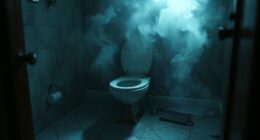Cognitive Behavioral Lucid Dreaming Therapy (CBLDT) offers a promising approach to boost mental health by combining psychological techniques with dream awareness. You’ll learn to recognize dream signs, practice mindfulness, and improve sleep habits—leading to better emotional regulation and insight into subconscious patterns. This therapy can help reduce nightmares, ease insomnia, and foster a healthier relationship with sleep. Keep exploring to uncover how this innovative method can support your overall well-being.
Key Takeaways
- CBLDT integrates CBT and dream control to improve sleep quality and address mental health issues like anxiety and PTSD.
- It promotes emotional regulation and subconscious insight through lucid dreaming, supporting mental health treatment.
- Techniques such as reality checks and journaling enhance dream awareness, aiding in the management of nightmares and insomnia.
- The therapy fosters gradual skill-building, empowering individuals to gain mastery over sleep and dream-related challenges.
- CBLDT offers a structured, personalized approach that combines psychological strategies with practical techniques for mental well-being.

Cognitive Behavioral Lucid Dreaming Therapy (CBLDT) combines the principles of cognitive-behavioral therapy with techniques that help you become aware of and control your dreams. This approach can be especially effective if you’re seeking to improve your sleep quality or manage sleep disorders. By focusing on dream induction, CBLDT guides you through methods that increase the likelihood of experiencing lucid dreams, where you’re conscious of dreaming and can influence the dream narrative. These techniques often include reality checks, mindfulness practices, and journaling, all aimed at sharpening your awareness both during waking hours and within your dreams. As you practice, you learn to recognize dream signs—specific cues that indicate you’re dreaming—which makes it easier to realize when you’re in a dream state.
If you’re struggling with sleep disorders such as insomnia or nightmares, CBLDT offers promising avenues for relief. Sleep disorders can disrupt your rest, leading to fatigue, anxiety, and a decreased quality of life. Through structured interventions, you learn to address the thoughts and behaviors that contribute to these issues. For example, cognitive restructuring helps you challenge and replace negative beliefs about sleep, while behavioral techniques promote healthier sleep habits. Additionally, by practicing dream induction methods, you may find yourself experiencing more vivid and controllable dreams, which can reduce anxiety related to nightmares or difficulty falling asleep. This sense of control can empower you to face sleep difficulties with a feeling of mastery rather than helplessness.
Research indicates that lucid dreaming can be a valuable tool for both mental health and sleep improvement by increasing awareness and emotional regulation during dreams. CBLDT emphasizes the importance of setting realistic goals and gradually building your skills. You might start by keeping a dream journal to enhance dream recall and identify patterns that signal when you’re dreaming. As you become more adept, you can incorporate techniques like wake-back-to-bed or visualization exercises to increase your chances of entering a lucid state. This process not only helps you gain insight into your subconscious but also provides a practical tool for managing sleep disruptions. Moreover, understanding the role of mental health in sleep quality can guide you in addressing underlying issues that affect your rest. Developing a mindfulness practice can further support emotional regulation and improve sleep quality. Incorporating behavioral techniques into your routine can help solidify healthy sleep habits and reduce the frequency of nightmares. Over time, you may notice improvements in your sleep quality, reduced frequency of nightmares, and an overall sense of calm about your sleep patterns.
Ultimately, CBLDT offers a personalized approach that combines psychological strategies with practical techniques, making it a valuable option for anyone looking to harness the potential of lucid dreaming to improve mental health and sleep. By actively engaging in the process, you’re taking control of your dreams and your sleep, fostering a healthier relationship with rest and your subconscious mind.
Frequently Asked Questions
Can This Therapy Treat Severe Mental Health Disorders?
You might wonder if this therapy can treat severe mental health disorders. While it offers tools like dream control and boosts mental resilience, it’s not a guaranteed cure for serious conditions. It can complement traditional treatments by helping manage symptoms and improve emotional regulation. However, always consult a mental health professional to confirm it’s appropriate for your specific situation, as severe disorders often require thorough care.
How Long Does It Typically Take to See Results?
Coincidences often hint at timing expectations you might overlook. Typically, you could notice progress indicators within a few weeks, but it varies based on your commitment and mental health needs. Some may see results in as little as a month, while others may need several months. Stay consistent, and focus on small improvements. Remember, patience and persistence are your best tools in observing meaningful change.
Are There Any Risks Involved With Lucid Dreaming Therapy?
You might wonder about lucid dreaming risks, but generally, therapy safety is high when guided properly. While some people experience sleep disruptions or vivid dreams, these are usually temporary. It’s important to follow professional advice to minimize any risks. If you’re aware of your limits and work with a trained therapist, lucid dreaming therapy can be a safe tool for mental health improvement.
Is Prior Experience With Lucid Dreaming Necessary?
Think you need a PhD in dreaming before trying lucid dreaming? Nope! Prior experience isn’t necessary. All you need is good dream recall and solid sleep hygiene to get started. Even if your dreams are fuzzy or rare, you can still learn to control them. So, don’t worry—jump right in, focus on your sleep habits, and enjoy exploring your mind’s wildest landscapes without a fancy diploma!
How Does This Therapy Compare to Traditional CBT?
You might wonder how this therapy compares to traditional CBT. Unlike standard CBT, it emphasizes dream induction techniques to unseal subconscious insights and build mental resilience. This approach helps you confront fears and improve emotional regulation through lucid dreaming practices. While traditional CBT targets thought patterns directly, this method integrates dream work, enhancing self-awareness and resilience in a unique, subconscious way. Both are effective, but this adds a creative, dream-focused dimension.
Conclusion
Imagine harnessing the power of your dreams to boost mental health—it’s like having your own personal oracle. With Cognitive Behavioral Lucid Dreaming Therapy, you can confront fears, reduce anxiety, and release creativity while sleeping. Don’t wait for a knight in shining armor; the key is in your mind. Embrace this revolutionary approach today and turn your nighttime adventures into a journey toward well-being—before dreams become just a myth.









